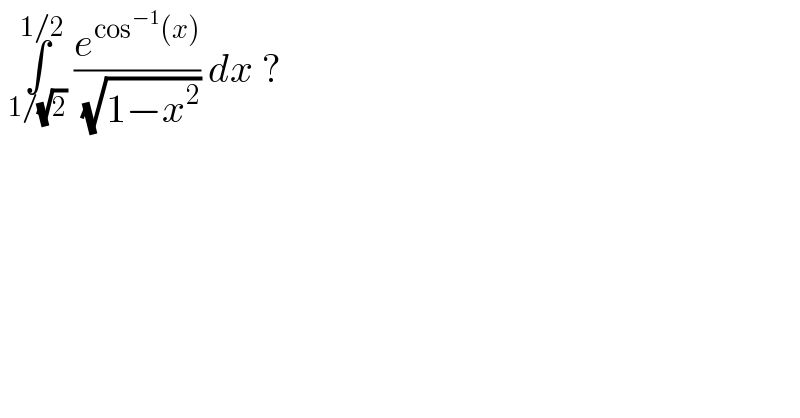
Question Number 124654 by benjo_mathlover last updated on 05/Dec/20

$$\:\underset{\mathrm{1}/\sqrt{\mathrm{2}}} {\overset{\mathrm{1}/\mathrm{2}} {\int}}\:\frac{{e}^{\mathrm{cos}^{−\mathrm{1}} \left({x}\right)} }{\:\sqrt{\mathrm{1}−{x}^{\mathrm{2}} }}\:{dx}\:?\: \\ $$
Commented by mohammad17 last updated on 05/Dec/20
![=−∫_(1/(√2)) ^( 1/2) ((−1)/( (√(1−x^2 ))))×e^(cos^(−1) (x)) dx =−[e^(cos^(−1) (x)) ]_(1/(√2)) ^(1/2) =−(e^(cos^(−1) ((1/2))) −e^(cos^(−1) ((1/( (√2))))) ) =e^(π/4) −e^(π/3) (mohammad Aldolaimy)](Q124671.png)
$$ \\ $$$$=−\int_{\mathrm{1}/\sqrt{\mathrm{2}}} ^{\:\mathrm{1}/\mathrm{2}} \:\frac{−\mathrm{1}}{\:\sqrt{\mathrm{1}−{x}^{\mathrm{2}} }}×{e}^{{cos}^{−\mathrm{1}} \left({x}\right)} {dx} \\ $$$$ \\ $$$$=−\left[{e}^{{cos}^{−\mathrm{1}} \left({x}\right)} \right]_{\mathrm{1}/\sqrt{\mathrm{2}}} ^{\mathrm{1}/\mathrm{2}} \:\:=−\left({e}^{{cos}^{−\mathrm{1}} \left(\frac{\mathrm{1}}{\mathrm{2}}\right)} −{e}^{{cos}^{−\mathrm{1}} \left(\frac{\mathrm{1}}{\:\sqrt{\mathrm{2}}}\right)} \right) \\ $$$$ \\ $$$$={e}^{\frac{\pi}{\mathrm{4}}} −{e}^{\frac{\pi}{\mathrm{3}}} \\ $$$$ \\ $$$$\left({mohammad}\:{Aldolaimy}\right) \\ $$
Answered by mathmax by abdo last updated on 05/Dec/20
![I=∫_(1/( (√2))) ^(1/2) (e^(arcosx) /( (√(1−x^2 ))))dx cha7gement x=cost give I =∫_(π/4) ^(π/3) (e^t /( (√(1−cos^2 t))))(−sint)dt =−∫_(π/4) ^(π/3) e^t dt =−[e^t ]_(π/4) ^(π/3) =e^(π/4) −e^(π/3)](Q124664.png)
$$\mathrm{I}=\int_{\frac{\mathrm{1}}{\:\sqrt{\mathrm{2}}}} ^{\frac{\mathrm{1}}{\mathrm{2}}} \:\frac{\mathrm{e}^{\mathrm{arcosx}} }{\:\sqrt{\mathrm{1}−\mathrm{x}^{\mathrm{2}} }}\mathrm{dx}\:\:\mathrm{cha7gement}\:\:\mathrm{x}=\mathrm{cost}\:\mathrm{give} \\ $$$$\mathrm{I}\:=\int_{\frac{\pi}{\mathrm{4}}} ^{\frac{\pi}{\mathrm{3}}} \:\frac{\mathrm{e}^{\mathrm{t}} }{\:\sqrt{\mathrm{1}−\mathrm{cos}^{\mathrm{2}} \mathrm{t}}}\left(−\mathrm{sint}\right)\mathrm{dt}\:=−\int_{\frac{\pi}{\mathrm{4}}} ^{\frac{\pi}{\mathrm{3}}} \:\mathrm{e}^{\mathrm{t}} \:\mathrm{dt}\:=−\left[\mathrm{e}^{\mathrm{t}} \right]_{\frac{\pi}{\mathrm{4}}} ^{\frac{\pi}{\mathrm{3}}} \\ $$$$=\mathrm{e}^{\frac{\pi}{\mathrm{4}}} −\mathrm{e}^{\frac{\pi}{\mathrm{3}}} \\ $$$$ \\ $$
Answered by liberty last updated on 05/Dec/20
![let z = cos^(−1) (x) ⇒x = cos z dx = −sin z dz ∫ (e^z /( (√(1−cos z)))) (−sin z) dz = −∫e^z dz = −e^z + c = −e^(cos^(−1) (x)) + c ∫_(1/( (√2))) ^( 1/2) (e^(cos^(−1) (x)) /( (√(1−x^2 )))) dx = − [e^(cos^(−1) (x)) ]_(1/( (√2))) ^(1/2) = − [ e^(π/3) −e^(π/4) ] = e^(π/4) −e^(π/3) .](Q124658.png)
$${let}\:{z}\:=\:\mathrm{cos}^{−\mathrm{1}} \left({x}\right)\:\Rightarrow{x}\:=\:\mathrm{cos}\:{z} \\ $$$$\:{dx}\:=\:−\mathrm{sin}\:{z}\:{dz}\: \\ $$$$\int\:\frac{{e}^{{z}} }{\:\sqrt{\mathrm{1}−\mathrm{cos}\:{z}}}\:\left(−\mathrm{sin}\:{z}\right)\:{dz}\:=\:−\int{e}^{{z}} \:{dz}\:=\:−{e}^{{z}} \:+\:{c} \\ $$$$\:=\:−{e}^{\mathrm{cos}^{−\mathrm{1}} \left({x}\right)} \:+\:{c}\: \\ $$$$\int_{\frac{\mathrm{1}}{\:\sqrt{\mathrm{2}}}} ^{\:\mathrm{1}/\mathrm{2}} \frac{{e}^{\mathrm{cos}^{−\mathrm{1}} \left({x}\right)} }{\:\sqrt{\mathrm{1}−{x}^{\mathrm{2}} }}\:{dx}\:=\:−\:\left[{e}^{\mathrm{cos}^{−\mathrm{1}} \left({x}\right)} \:\right]_{\frac{\mathrm{1}}{\:\sqrt{\mathrm{2}}}} ^{\frac{\mathrm{1}}{\mathrm{2}}} \\ $$$$\:=\:−\:\left[\:{e}^{\frac{\pi}{\mathrm{3}}} −{e}^{\frac{\pi}{\mathrm{4}}} \:\right]\:=\:{e}^{\frac{\pi}{\mathrm{4}}} −{e}^{\frac{\pi}{\mathrm{3}}} . \\ $$
Answered by Ar Brandon last updated on 05/Dec/20
![Ω=∫_(1/(√2)) ^(1/2) (e^(cos^(−1) (x)) /( (√(1−x^2 ))))dx d(cos^(−1) (x))=((−1)/( (√(1−x^2 ))))dx Ω=−∫_(1/(√2)) ^(1/2) e^(cos^(−1) (x)) d(cos^(−1) (x)) =−[e^(cos^(−1) (x)) ]_(1/(√2)) ^(1/2) =e^(π/4) −e^(π/3)](Q124665.png)
$$\Omega=\int_{\mathrm{1}/\sqrt{\mathrm{2}}} ^{\mathrm{1}/\mathrm{2}} \frac{\mathrm{e}^{\mathrm{cos}^{−\mathrm{1}} \left(\mathrm{x}\right)} }{\:\sqrt{\mathrm{1}−\mathrm{x}^{\mathrm{2}} }}\mathrm{dx} \\ $$$$\mathrm{d}\left(\mathrm{cos}^{−\mathrm{1}} \left(\mathrm{x}\right)\right)=\frac{−\mathrm{1}}{\:\sqrt{\mathrm{1}−\mathrm{x}^{\mathrm{2}} }}\mathrm{dx} \\ $$$$\Omega=−\int_{\mathrm{1}/\sqrt{\mathrm{2}}} ^{\mathrm{1}/\mathrm{2}} \mathrm{e}^{\mathrm{cos}^{−\mathrm{1}} \left(\mathrm{x}\right)} \mathrm{d}\left(\mathrm{cos}^{−\mathrm{1}} \left(\mathrm{x}\right)\right) \\ $$$$\:\:\:\:=−\left[\mathrm{e}^{\mathrm{cos}^{−\mathrm{1}} \left(\mathrm{x}\right)} \right]_{\mathrm{1}/\sqrt{\mathrm{2}}} ^{\mathrm{1}/\mathrm{2}} =\mathrm{e}^{\pi/\mathrm{4}} −\mathrm{e}^{\pi/\mathrm{3}} \\ $$
